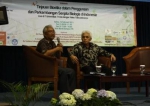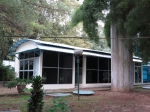Solving the Tuban Water Crisis Problem Using a Geolistic Method

source - jcompa on Freepik
BANDUNG, itb.ac.id – Almost all lives on earth are depended on water, especially groundwater. Groundwater is part of the water cycle that is retained deep inside the ground and moves slowly through the formation of geologic aquifers. In some parts of the world, its existence is considered crucial because of its ability to be diverted for human needs thereby facilitating poverty reduction and mitigation.
On the other side, surface water is water that flows from a higher elevation to the watershed area, then continues its flow to a river, reservoir, or sea. Generally, water that flows in the watershed area contains pollution and other dangerous chemicals. The condition of river sediment can also cause water pollution through waste and mud that had been polluted by other pollution. As a result, it creates water flow dysfunction and can increase the risk of flood and drought.
According to Dr.rer.nat Widodo, S.T., M.T., a Geophysics Engineering lecturer from ITB, clean water supply holds a very important role in maintaining public health. The reason is that most of the public water needs are supplied by groundwater which geologically, requires thousands of years to replenish itself. "With this condition, water can be categorized as a non-renewable natural resource and can be very essential if compared to the human lifecycle," he said.
Drought Disaster in Tuban
Geologically, the Tuban region is dominated by karst mountains and has a dry climate of 94,73%. Grabagan Village is one of the villages that experienced drought. A large part of its 10.492 residents was impacted by a clean water crisis, especially at the Klampeyan Hamlet which until now for its clean water supply depended on a mobile water truck. The supply from the drinking water company is still very minimal due to the low water flow debit in the area.
To solve this issue, the discovery of new clean water sources using geophysics technology is urgently needed. This technology can find the location of a groundwater aquifer layer by analyzing the physical characteristic of underground rock layers around the area. Through the community service program, the Institute for Research and Community Service (LPPM) ITB and ITB academic community were given chance to contribute in solving the clean water crisis problem. The community service program was carried out for approximately 6 months in 2021 in some of the worst drought-experiencing areas. This program was headed by Dr.rer.nat Widodo.
Geophysics-method Exploration
A technology that was implemented at the Grabagan Village has the ability to measure voltage differences between rock layers using a geolistic method. This method is called Vertical Electrical Sounding (VES) and measures the different potentials retained by each layer of rock vertically. The data that was collected will give a rough illustration of existing layers beneath the ground.
Based on the data that was collected on the field and geophysics data inversion process, it was known that the aquifer layer is located at the depth of around 42 to 110 meters and it was suspected that there are sediment rocks with an impedance of 1-4 ohm meter. Meanwhile, the first layer has the characteristic of clay and conglomerate rocks reaching a depth of 42 meters with an impedance of 5-110 ohm-meter. The bedrock is indicated to be a metamorphic type in the form of limestone, which was deposited after the first layer, which is at the depth of 110 meters. The aquifer that was discovered is a confined aquifer with a metamorphic bedrock.
Drilling Exploitation
After the indication of an aquifer layer was discovered, the second step is to drill for the groundwater. The groundwater exploitation from drilled wells was done using a powered pump. "If groundwater is confined and water sprung naturally, a pump can be used to distribute the water.
After that, the groundwater will be collected or used accordingly," explained Dr.rer.nat Widodo. The drilling in the community service program area was carried out until reaching a depth of 85 meters.
Using the geolistic method, the community service succeeded in discovering a large amount of clean water with a flow rate of 30 liter/second. In the future, the seven hamlets that are resided by over 1200 people will use the water source for their daily needs. The water can also be used to irrigate their field which so far had only used retained rainwater, thus improving the hamlet's economy.
Neng, the Chief of Grabagan Village, appreciated ITB community service team that had helped her village solve the clean water issue, "I representing my people thank Mr. Widodo and ITB who have succeeded in providing clean water through this community service program." The same thing was also conveyed by the Chief of Klampeyan Hamlet, Darsono. "Exploration and clean water drilling will be very beneficial for the Klampeyan Hamlet resident that has faced clean water issues for a long time and will also improve our community health," he concluded near the end of the program, September 2021.
*This article has been published in Media Indonesia rubric Rekacipta ITB, the complete article can be read at
https://pengabdian.lppm.itb.ac.id
Reporter: Sekar Dianwidi Bisowarno (Bioengineering, 2019)
Translator: Favian Aldilla R (Civil Engineering, 2019)

scan for download







